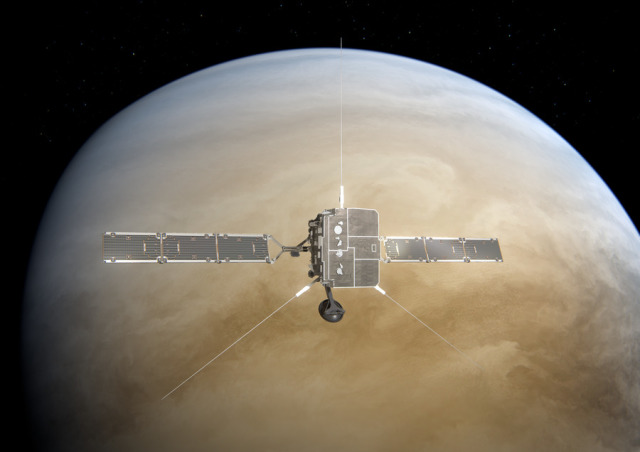The spacecraft will fly over the planet with an interval of only 33 hours
PARIS, August 2. /TASS/. The automatic spacecraft Solar Orbiter and BepiColombo will fly over the planet Venus on August 9 and 10, 2021. This was announced on Monday by the European Space Agency (ESA).
"Solar Orbiter and BepiColombo will go down in the history of space exploration, flying over Venus with an interval of only 33 hours on August 9 and 10," the European science agency emphasizes. It clarifies that the gravitational maneuver at Venus is necessary to direct them after that towards Mercury, which is the main goal for BepiColombo, while the main task of the Solar Orbiter is to study the Sun .
"The double flyby will provide an unprecedented opportunity to study the environment of Venus from different points at the same time. Moreover, those zones that are usually not visited by special orbital research vehicles, " the ESA notes.
The Solar Orbiter, created in partnership between ESA and NASA, will be the first to fly near Venus. This will happen on August 9 at 06: 42 Paris time (07:42 Moscow time). The flight will be made at a distance of 7,995 km from the surface of the planet. During its mission, the Solar Orbiter has already performed a gravitational maneuver near Venus on December 27, 2020.
The second to approach Venus will be the BepiColombo spacecraft, created by ESA in partnership with the Japan Aerospace Exploration Agency. The flight will take place starting from 15:48 Paris time (16:48 Moscow time) on August 10 at a distance of only 550 km from the planet. This is the second flyby of Venus for this device - the first took place on October 15, 2020. To save fuel during the flight, BepiColombo, according to its program, performs nine gravitational maneuvers - one at Earth, two at Venus and six times at Mercury.
Valuable information
Two of the three BepiColombo surveillance cameras will take black-and-white images both during the close approach phase and in the following days, during the distance from it. The images will then be gradually transmitted to Earth. SoloHI thermal imaging device. installed on the Solar Orbiter, it should allow you to observe the dark side of Venus. According to ESA, " the data collected during these flights will be useful, in particular, for the future ESA orbiter headed to Venus - EnVision, which will be launched in the 30s of this century."
According to the plans of the space agency, " on the night of October 2, BepiColombo will see its destination for the first time, making its first of six flights to Mercury, from which it will pass at a distance of only 200 km." As for the Solar Orbiter, on November 27, it will make its last flight near the Earth at a distance of 460 km, marking the beginning of its main mission. He will continue to make regular flights of Venus in the future, in order to gradually increase the inclination of his orbit in this way, which will allow him to better observe the unexplored polar regions of the Sun.

